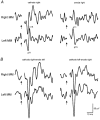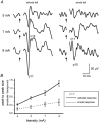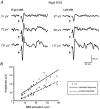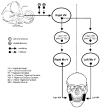A short latency vestibulomasseteric reflex evoked by electrical stimulation over the mastoid in healthy humans
- PMID: 12949229
- PMCID: PMC2343496
- DOI: 10.1113/jphysiol.2003.047274
A short latency vestibulomasseteric reflex evoked by electrical stimulation over the mastoid in healthy humans
Abstract
We describe EMG responses recorded in active masseter muscles following unilateral and bilateral electrical vestibular stimulation (EVS, current pulses of 5 mA intensity, 2 ms duration, 3 Hz frequency). Averaged responses in unrectified masseter EMG induced by unilateral EVS were examined in 16 healthy subjects; effects induced by bilateral (transmastoid) stimulation were studied in 10 subjects. Results showed that unilateral as well as bilateral EVS induces bilaterally a clear biphasic response (onset latency ranging from 7.2 to 8.8 ms), that is of equal amplitude and latency contra- and ipsilateral to the stimulation site. In all subjects, unilateral cathodal stimulation induced a positive-negative response termed p11/n15 according to its mean peak latency; the anodal stimulation induced a response of opposite polarity (n11/p15) in 11/16 subjects. Cathodal responses were significantly larger than anodal responses. Bilateral stimulation induced a p11/n15 response significantly larger than that induced by the unilateral cathodal stimulation. Recordings from single motor units showed that responses to cathodal stimulation corresponded to a brief (2-4 ms) silent period in motor unit discharge rate. The magnitude of EVS-induced masseter response was linearly related to current intensity and scaled with the mean level of EMG activity. The size of the p11/n15 response was asymmetrically modulated when subjects were tilted on both sides; in contrast head rotation did not exert any influence. Control experiments excluded a possible role of cutaneous receptors in generating the masseter response. We conclude that transmastoid electrical stimulation evokes vestibulomasseteric reflexes in healthy humans at latencies consistent with a di-trisynaptic pathway.
Figures






Similar articles
-
A sound-evoked vestibulomasseteric reflex in healthy humans.J Neurophysiol. 2005 May;93(5):2739-51. doi: 10.1152/jn.01005.2004. Epub 2004 Dec 15. J Neurophysiol. 2005. PMID: 15601734 Clinical Trial.
-
The vestibular system modulates masseter muscle activity.J Vestib Res. 1993 Summer;3(2):163-71. J Vestib Res. 1993. PMID: 8275251
-
Origin of sound-evoked EMG responses in human masseter muscles.J Physiol. 2007 Apr 1;580(Pt 1):195-209. doi: 10.1113/jphysiol.2006.123240. Epub 2007 Jan 18. J Physiol. 2007. PMID: 17234698 Free PMC article. Clinical Trial.
-
Reflex responses of masseter muscles to sound.Clin Neurophysiol. 2010 Oct;121(10):1690-9. doi: 10.1016/j.clinph.2009.11.093. Epub 2010 May 5. Clin Neurophysiol. 2010. PMID: 20447862 Review.
-
Masseter reflexes modulated by pain.Mov Disord. 2002;17 Suppl 2:S45-8. doi: 10.1002/mds.10058. Mov Disord. 2002. PMID: 11836754 Review. No abstract available.
Cited by
-
Vestibular-evoked myogenic potentials in miniature pigs.J Otol. 2016 Jun;11(2):88-93. doi: 10.1016/j.joto.2016.05.003. Epub 2016 Jun 10. J Otol. 2016. PMID: 29937816 Free PMC article.
-
Convergent innervations of mesencephalic trigeminal and vestibular nuclei neurons onto oculomotor and pre-oculomotor neurons-Tract tracing and triple labeling in rats.PLoS One. 2022 Nov 28;17(11):e0278205. doi: 10.1371/journal.pone.0278205. eCollection 2022. PLoS One. 2022. PMID: 36441755 Free PMC article.
-
Abnormalities of vestibular-evoked myogenic potentials in idiopathic Parkinson's disease are associated with clinical evidence of brainstem involvement.Neurol Sci. 2015 Jun;36(6):995-1001. doi: 10.1007/s10072-014-2054-4. Epub 2015 Jan 8. Neurol Sci. 2015. PMID: 25567081
-
Test-Retest Reliability of Tone Burst-Induced 500 Hz Air-Conduction Masseter Vestibular Evoked Myogenic Potential in Healthy Individuals.J Audiol Otol. 2024 Oct;28(4):278-283. doi: 10.7874/jao.2023.00633. Epub 2024 Jul 9. J Audiol Otol. 2024. PMID: 38973324 Free PMC article.
-
Masseter Vestibular evoked myogenic potentials: A new tool to assess the vestibulomasseteric reflex pathway.J Otol. 2024 Jan;19(1):46-54. doi: 10.1016/j.joto.2023.12.005. Epub 2023 Dec 29. J Otol. 2024. PMID: 38313757 Free PMC article. Review.
References
-
- Baird RA, Desmadryl G, Fernandez C, Goldberg JM. The vestibular nerve of the chinchilla. II. Relation between afferent response properties and peripheral innervation patterns in the semicircular canals. J Neurophysiol. 1988;60:182–203. - PubMed
-
- Bense S, Stephan T, Yousry TA, Brandt T, Dieterich M. Multisensory cortical signal increases and decreases during vestibular galvanic stimulation (fMRI) J Neurophysiol. 2001;85:886–899. - PubMed
-
- Berthoz A. Adaptive mechanisms in eye-head coordination. In: Berthoz A, Melvill Jones G, editors. Rev Oculomotor Control. Adaptative Mechanism in Gaze Control. Facts and Theories. Vol. 1. Amsterdam: Elsevier; 1985. pp. 178–201.
-
- Bickford RG, Jacobson JL, Cody D TH. Nature of average evoked potentials to sound and other stimuli in man. Ann N Y Acad Sci. 1964;112:204–218. - PubMed
-
- Britton TC, Day BL, Brown P, Rothwell JC, Thompson PD, Marsden CD. Postural electromyographic responses in the arm and leg following galvanic vestibular stimulation in man. Exp Brain Res. 1993;94:143–151. - PubMed
Publication types
MeSH terms
LinkOut - more resources
Full Text Sources

